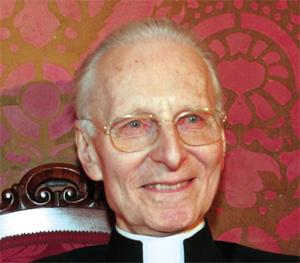
In the May 2010 edition of Courrier de Rome (n°333), Professor Paolo Pasqualucci offers an enlightening commentary on Msgr. Brunero Gherardini’s study, that appeared in the theological journal Divinitas, under the title Quod et tradidi vobis – La tradizione vita e giovinezza della Chiesa (Quod et tradidi vobis. Tradition, life and youth of the Church), a study that is also taken up again in a volume by Casa Mariana Editrice.
Msgr. Gherardini who is the author of Vatican II: An Open Discussion, which appeared in french early this year, presents in Quod et tradidi vobis a very pertinent analysis of the theological debate between Tradition and Vatican Council II. Here is the large extract that can be found in the Courrier de Rome, offering a list of 9 stumbling blocks; to which list we have added the three paragraphs that follow, where Msgr. Gherardini does not hesitate to pass a very explicit personal judgment.
“In my effort to establish a synthesis of the positions defended by Bishop Lefebvre in favor of Tradition, and without pretending to treat exhaustively of the subject, it seems to me that the conflict establishes itself as follows:
“From what has just been said, one can easily deduce how the Society of St. Pius X understands Tradition. Indeed, Tradition is the exact opposite of what the Society denies and of what it is opposed to. Directly or in between the lines, the Society refuses the innovations of the Council’s documents and their postconciliar applications, and stands in opposition to the savage use that has been so casually made of them.
“It is true that in the writings of the Society of St. Pius X the concept of Tradition is not often explained, and we do not find it systematically developed. But what is understood, just like what is conjectured, never remains in the dark. At the base of all is “the faith of all times” for whose safeguard the Society was born. “Safeguard” indicates an opposition to something present or possible, in favor of its contrary or of its replacement. The “faith of all times” is the value that Msgr. Lefebvre wished to safeguard, a value that is being replaced by all the attenuations, reinterpretations, reductions and negations of conciliar ad postconciliar times. This “faith of all times” is the loud and clear echo of the Augustinian teaching summed up in St. Vincent de Lérins’ words: “Quod semper, quod ubique, quod ab omnibus creditum est”[1]. The very institution of the Society, with its first goal which is the priestly formation, obeys this ideal and the commitment to safeguarding it. Safeguard the faith and combat error.
“I will not enter into the details of the relations and difficulties between the Holy See and the Society of Saint Pius X. I stick to the common theme of Tradition and I observe that “safeguard the faith and combat error” should be the ideal and commitment as much of the Church as of her sons. In the light of this, it is difficult for me to understand how the reproach of an “incomplete and contradictory Tradition” formulated by John Paul II in 1988[2], could have any real grounds. What I understand is that it has nothing to do with the “spirit of Assisi”[3]. (Translated from the Italian – DICI n°218, July 10, 2010)
Brunero Gherardini, is a renowned, 85-year-old theologian of the Roman school, is a canon of St. Peter’s Basilica, secretary for the Pontifical Academy of Theology, professor emeritus at the Pontifical Lateran University, and editor of
Divinitas magazine.[2] Motu Proprio Ecclesia Dei, July 2, 1988.
[3] Msgr. Gherardini, Quod et tradidi vobis – La tradizione vita e giovinezza della Chiesa, Ed. Casa Mariana Editrice, pp. 241-244.